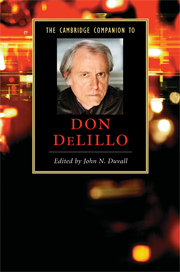Book contents
- Frontmatter
- Introduction: The power of history and the persistence of mystery
- PART I AESTHETIC AND CULTURAL INFLUENCES
- PART II EARLY FICTION
- PART III MAJOR NOVELS
- 6 White Noise
- 7 Libra
- 8 Underworld
- PART IV THEMES AND ISSUES
- Conclusion: Writing amid the ruins: 9/11 and Cosmopolis
- Select bibliography
- Guide to further reading
- Index
- Series List
7 - Libra
from PART III - MAJOR NOVELS
Published online by Cambridge University Press: 28 June 2008
- Frontmatter
- Introduction: The power of history and the persistence of mystery
- PART I AESTHETIC AND CULTURAL INFLUENCES
- PART II EARLY FICTION
- PART III MAJOR NOVELS
- 6 White Noise
- 7 Libra
- 8 Underworld
- PART IV THEMES AND ISSUES
- Conclusion: Writing amid the ruins: 9/11 and Cosmopolis
- Select bibliography
- Guide to further reading
- Index
- Series List
Summary
Don DeLillo once suggested that the assassination of President John F. Kennedy made him into the writer he became – shaped, that is, the novelist who wrote Libra (1988), a charged historical novel about the life of Lee Harvey Oswald and the assassination of JFK. “As I was working on Libra,” DeLillo told an interviewer, “it occurred to me that a lot of tendencies in my first eight novels seemed to be collecting around the dark center of the assassination.” By the time he set to work on his first direct treatment of the assassination, an essay published in Rolling Stone under the title “American Blood: A Journey Through the Labyrinth of Dallas and JFK,” DeLillo had already written at length of violence, conspiracy, and the seductive lure of paranoia. Libra, which followed DeLillo's breakthrough novel White Noise (1985), took a little more than three years to write, a remarkably short period of time given the extensive research the book demanded, and was published in 1988, in time for the twenty-fifth anniversary of the assassination. In Libra DeLillo approached recent American history directly for the first time, drawing from the evidence, testimony, and analysis compiled in the aftermath of Kennedy's murder. The novel recreates the traumatic moment in Dallas, the “seven seconds that broke the back of the American century” (L 181), and offers, as the author's note appended to the first edition puts it, “a way of thinking about the assassination without being constrained by half-facts or overwhelmed by possibilities, by the tide of speculation that widens with the years” (L 458). But the novel is more than just the imaginative recreation of a particularly important and troublingly elusive historical event; it is also a speculative study of the origins of our own historical and cultural moment.
- Type
- Chapter
- Information
- The Cambridge Companion to Don DeLillo , pp. 94 - 107Publisher: Cambridge University PressPrint publication year: 2008
- 3
- Cited by

